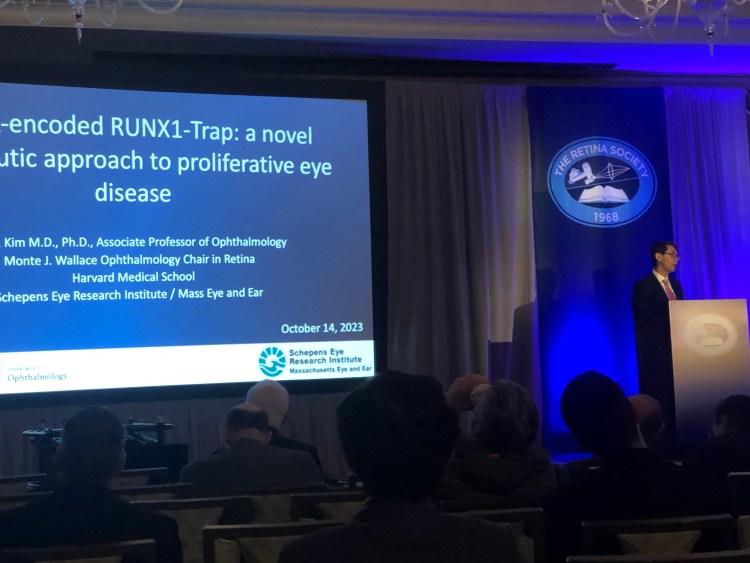Warren Pan, MD, MPhil, PhD
University of Michigan
The following sessions on Saturday morning were moderated by Dean Eliott, MD and Maria Berrocal, MD.

First, Dr. Leo Kim, MD, PhD presented his work on the mRNA-Encoded RUNX1-Trap: A Novel Therapeutic Approach to Proliferative Eye Disease.
Dr. Kim’s work focuses on addressing the need for novel therapeutics to treat proliferative eye diseases. In previous experiments, Dr. Kim established the importance of the transcription factor RUNX1 in both pathologic fibrosis and angiogenesis. Now, he has developed a synthetic mRNA-encoded dominant negative regulator of RUNX1 (RUNX1-trap) via a lipid nanoparticle delivery mechanism with broad therapeutic implications for the eye. His team found this innovative treatment strategy to effectively and significantly address PVR and fibrosis in a cell-culture, rabbit, and patient explant model. In addition, Dr. Kim’s group examined RUNX1-trap in a laser CNVM model, and found a significant reduction in pathologic angiogenesis. In summary, this work marks the start of utilizing mRNA technology in retinal disease, and these preclinical data highlight a promising treatment target for proliferative retinal diseases.

Next, Dr. Marco Zarbin, MD, PhD presented The Phase 3 GUARD Trial of ADX-2191 (Methotrexate for Intravitreal Administration) for the Prevention of Proliferative Vitreoretinopathy and Other Postoperative Complications.
Patients with recurrent retinal detachment due to PVR with at least 3 clock hours of star-folds or retinal detachment after open globe injury were recruited for the multicenter GUARD trial. While patients were initially randomized to either the intervention or control cohort, during the study all patients were switched to the intervention arm. Intervention consisted of 13 total injections of ADX-2191, a vitreous-optimized form of methotrexate, over a four-month period.
The primary end point was achieved with fewer recurrent retinal detachments found in the intervention arm (18.8%) when compared to the historical controls (38.7%) of two previous randomized controlled trials with similar enrollment criteria to the GUARD trial (Banerjee Ophthalmology 2017; Schiff Arch Ophthalmol 2007) up to week 24. The secondary endpoint compared the rates of recurrent retinal detachments between the GUARD intervention cohort with the GUARD control cohort (before every enrolled trial patient joined the intervention arm, as above), and did not find a statistically significant difference between the trial intervention (16%) and control cohorts (23%), although this was underpowered. Other secondary outcomes included BCVA, membrane formation, hypotony and macular thickness. Post-hoc meta-analysis of all secondary endpoints in aggregate showed a benefit for the intervention cohort compared to the control cohort (OR 0.6, p=0.047).
Adverse events were also significantly lower in aggregate for the intervention versus control cohort (OR 0.3, p=0.002), especially with fewer events of ocular inflammation and ocular hypertension. However, rates of punctate keratitis were higher in the intervention cohort, although significantly lower at 16.2% compared to the published compounded methotrexate figure of 58%. The speaker concluded by highlighting anecdotal cases of significantly decreased fibrosis observed in ADX-2191-treated surgical patients.